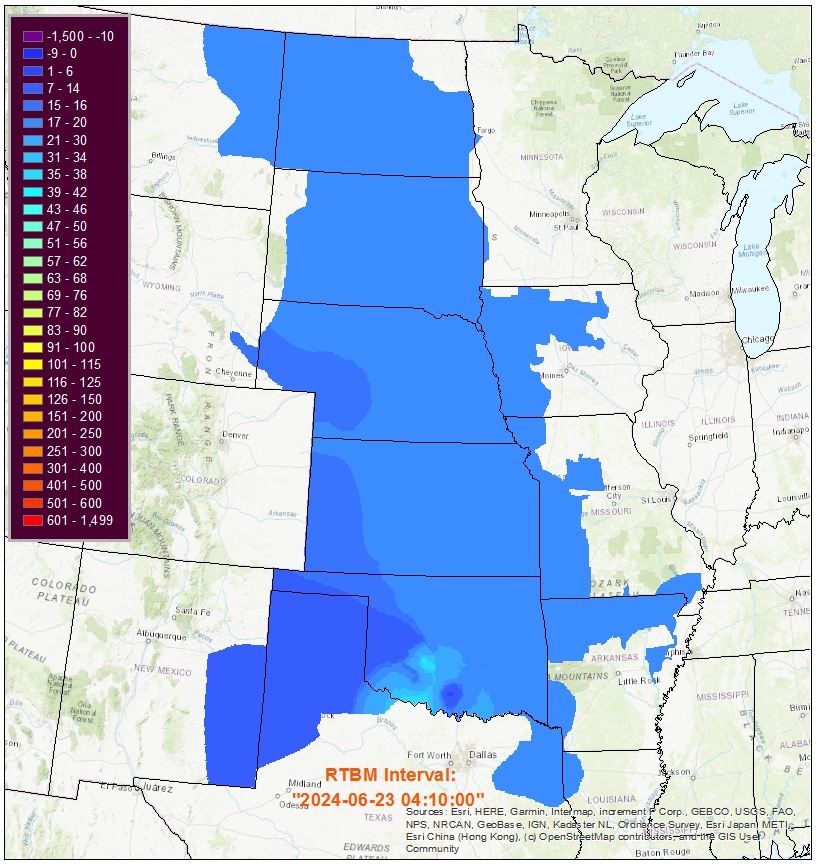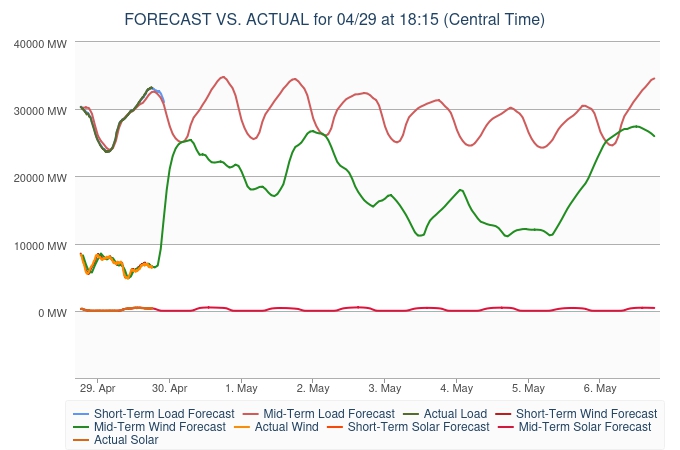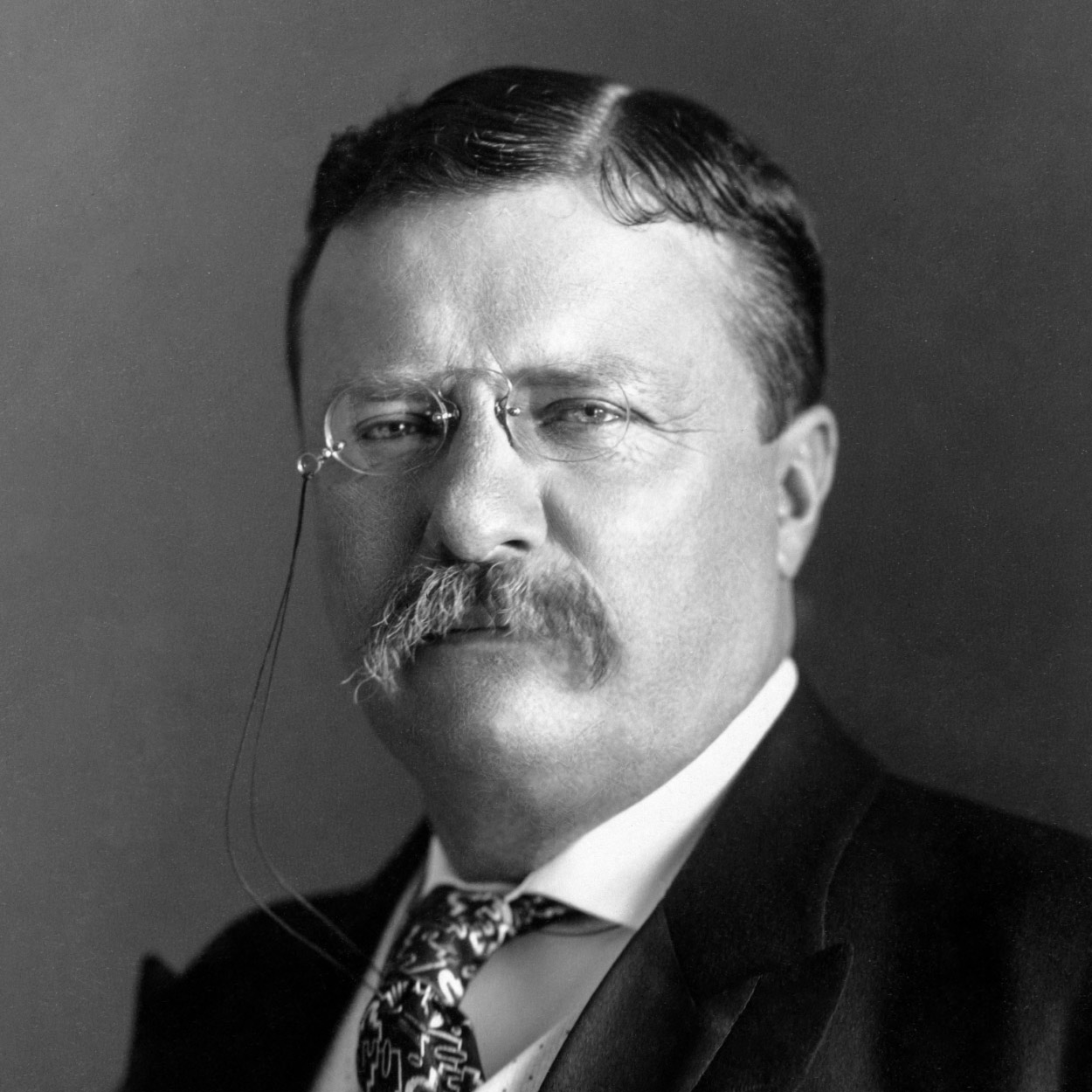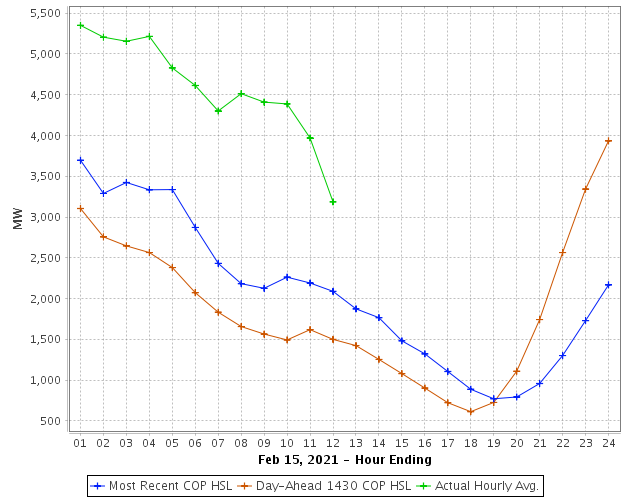|
|
Post by billhammond on Feb 15, 2021 16:12:42 GMT -5
(Bloomberg) -- Blackouts trigged by frigid weather are spreading across the central U.S. and into Mexico as an energy crisis that’s already brought Texas’s power grid to its knees deepens.
As more than 2 million homes in Texas are already without power, the operator of an grid spanning 14 states from North Dakota to Oklahoma ordered utilities to start rotating outages to protect the system from failing amid surging demand for electricity. The outages have also spread into Mexico.
“In our history as a grid operator, this is an unprecedented event,” the grid operator, called the Southwest Power Pool, said in a statement Monday.
The brutal cold striking Texas -- ironically the capital of the U.S. energy industry and home of some of the world’s largest oil and gas companies -- is emblematic of a world facing more unpredictable weather due to the rising impact of climate change. The outages underscore how as the globe moves away from fossil fuels into an all-electrified system that relies more and more on renewable energy, the grid becomes more vulnerable too.
Such weather conditions are very rare in much of Texas, and they have unleashed chaos on the ground. In Houston, the state’s largest city, roads are iced over and there are long lines to refill household propane canisters. Firewood is selling out.
Besides the human impact, the cold is wreaking havoc on the energy industry itself. Oil production in the Permian has dropped by 1 million barrels a day, helping U.S. crude prices to trade above $60 a barrel for the first time in more than year. The region’s industrial plants built to cope torrid summers rather than arctic weather, and the biggest U.S. oil refinery went offline on Monday, reducing the supply of gasoline and other fuels.
Large swaths of Dallas, Houston and other cities have been plunged into darkness as extreme cold and surging demand for heat pushes generators to the brink. The outages began as controlled, rolling power cuts but have cascaded into prolonged blackouts in some areas.
“We anticipate we will need to continue these controlled outages for the rest of today and perhaps all day tomorrow,” Dan Woodfin, a senior director for the Electric Reliability Council of Texas, which managed the state’s power grid, said during a briefing Monday.
In Mexico, at least 400,000 homes, businesses and other users lost power as the cold in Texas triggered a natural gas shortage and forced power plants offline. About 60% of those impacted had their power restored by midday, according to the grid operator, Cenace.
In the last six months, extreme temperatures have led to rolling blackouts in the two most populous U.S. states. In August, California grid operators shut off power when record heat push demand beyond capacity, and now Texas’ record cold has led to the same result.
The extreme cold appears to have caught Texas’s highly decentralized electricity market by surprise. Power plants with a combined capacity of more than 34 gigawatts were forced offline overnight, including nuclear reactors, coal and gas generators and wind farms, Woodfin said. It’s not clear why, he added.
Wind power in particular appears to have been a major victim of the weather conditions, with turbine blades rendered inoperable due to ice, a phenomenon that reduces efficiency can ultimately stop them from spinning. Wind generation has more than halved to 4.2 gigawatts.
Power is going to continue to be cut across the state through Monday and potentially into Tuesday morning until enough generators come back online, Woodfin said.
“Every grid operator and every electric company is fighting to restore power right now,” said Bill Magness, head of the Electric Reliability Council of Texas, which runs the state’s grid.
These are the first rolling blackouts caused by cold weather since 2011 in Texas. Spikes in electricity demand usually happen in summer in Texas when air conditioning use rises. A loss of frequency on the grid has caused 30 gigawatts of generation to halt. Many stations will have been undergoing scheduled maintenance, leaving the grid more exposed during unusually large spikes in demand.
Parts of Texas were colder than Alaska, according to the National Weather Service. The temperature at 5 a.m. in Houston was 18 degrees Fahrenheit, matching the reading in Anchorage. In the Dallas-Fort Worth area it was 5 degrees Fahrenheit.
Frigid temperatures and a parade of storms in the U.S. follow other instances of extreme winter weather this year that have snarled ports and upended energy markets in Asia and Europe. Texas, which isn’t accustomed to winter’s full fury, is getting a big taste. President Joe Biden declared a state of emergency, mobilizing federal assistance to aid local response efforts.
Power crunch
The average spot price for power across the Texas grid hit the state’s $9,000 per megawatt-hour price cap shortly after 9:30 a.m. local time. LNG exports from the U.S. also plummeted after the freeze shut ports and wells, and oil production also took a hit, with Permian oil production plunging by as much as one million barrels a day. West Texas Intermediate futures rose by as much as 2.5%, above $60 a barrel for the first time in more than a year.
Cold Weather Cuts Permian Oil Output by 1 Million Barrels a Day
The cut to crude supplies is threatening to unleash a rush for everything from propane to heating oil, fuels that are used in mobile heating devices.
Odessa in West Texas, one of the largest cities in the Permian Basin, still has power, but San Antonio has lost power with rolling blackouts lasting 10-15 minutes, according to sources on the ground.
Houston may pick up as much as 2 inches (5 centimeters) of snow overnight, along with ice and sleet, the National Weather Service said. It will get hit by another storm bringing ice and freezing rain Wednesday.
“It is going to be a cold week,” said David Roth, a senior branch forecaster at the U.S. Weather Prediction Center. “The southern plains are in a cold pattern and it is going to take a while for them to break out of it.”
|
|
|
|
Post by brucemacneill on Feb 15, 2021 16:33:01 GMT -5
Guess they should get a gas pipeline from some place fracking gas. Global Warming isn't working.
|
|
|
|
Post by millring on Feb 15, 2021 16:52:10 GMT -5
The outages underscore how as the globe moves away from fossil fuels into an all-electrified system that relies more and more on renewable energy, the grid becomes more vulnerable too. This sounds eerily familiar. Like I've heard it somewhere else recently. Gas prices are also rising. Who could have predicted this? |
|
|
|
Post by Village Idiot on Feb 16, 2021 2:03:19 GMT -5
Nostradamus.
|
|
|
|
Post by millring on Feb 16, 2021 7:41:33 GMT -5
|
|
|
|
Post by patrick on Feb 16, 2021 11:02:43 GMT -5
Actually, the losses due to wind being down are minor. Texas doesn't plan on getting much wind in the winter anyway. There are massive shortages across ALL sources of power in Texas.
The real problem is that Texas simply doesn't have an energy system designed for this weather. They can generate lots of power in the summer from wind and solar for all those air conditioners, but they simply aren't set up to provide power to all those homes using electricity for heat. Oil and gas aren't helping, US oil production has dropped by 2 MM barrels per day, causing problems at oil refineries. Look for rising gasoline prices as a result. And everyone is shifting to gas, which is now in short supply. Nuclear also seems to be underperforming.
|
|
|
|
Post by epaul on Feb 16, 2021 11:33:54 GMT -5
The Southwest Power Pool grid system is the grid coordinator just west of MISO (earlier thread). The two systems overlap. In North Dakota, for instance, Minnkota Power (with MISO) overlaps service territory with Basin Electric (with Southwest Power Pool). Similar situations exist in other states. The two grids share some common ground where they meet. MISO is about twice the size of Southwest Power Pool (in terms of Megawatts managed, 80,000 MW on average vs 40,000 MW). This due to larger population base it serves. Southwest Power Pool territory  MISO territory  If you go to the respective home pages, you can see the current power draw and the percentage of that current draw that is filled by various energy sources. Each site lists current consumption. Yesterday's consumption (draw) on the MISO grid was about as high as I have ever seen it. Good news is that is dropping and today's draw (while still quite high) is a good bit lower than what they had forecasted (good news provided that the reason the draw is down isn't because a bunch of power lines are down). - Note that MISO and Southwest Power Pool are each producing about 4,000 MW of wind power at this hour, but due to Southwest's lesser power draw (half of MISO's), wind represents a higher percentage of the total energy pie. Cool something. On the Southwest Power Pool homepage, to the right of the piechart, there is a graph comparing the current amount of wind energy being generated to the forecasted amount  The green line is the forecasted wind power. The yellow line overlying the green line is the actual wind power generated. There is a significant drop off near the end that, while it looks small, isn't... and no doubt it caused a scramble yesterday. You also will note that the forecasted consumption power consumption falls by the end of Feb. (Spring is coming) and the amount of wind power increases. Spring and Fall are the glory days of wind power. Wind is up and consumption is down (minimal heating or cooling demands). In the Southwest Power Pool, come Spring, wind power can approach 30% of this reduced demand. In MISO, due to the greater demand for power (population) in its region, wind will generally top out at 15% on the best Spring days. Come summer, wind goes down and consumption goes up. In most of the country, 90% of it, summer represents the highest current draw, higher than winter (due to AC use). Southwest Power Pool HomeMISO Home |
|
|
|
Post by epaul on Feb 16, 2021 12:10:56 GMT -5
Gas is being called on to do an awful lot in this country. It is being called on to replace the coal power that is being lost, which is a job all by itself, plus it has to account for the ups and downs of wind. When wind is working, gas has to cut its output and when wind isn't working, gas has to jack its production up to make up for wind's dump. The demands on gas are extraordinary...
and it is a physical property of gas that when the temps drop, flow will slow. Just the way it is. And when the demand is high and it has to do its own job plus wind's, and the too few and too small pipes lose some flow due to extremely low temps, it can't keep up.
I have a hard time believing there were any temperatures anywhere near Texas that were low enough to significantly affect gas flow (it has happened in MN). But, a lot is being demanded of gas, at times, too much.
|
|
|
|
Post by james on Feb 16, 2021 12:13:28 GMT -5
|
|
|
|
Post by epaul on Feb 16, 2021 12:45:44 GMT -5
[corrected again] Coal, gas, and nuke plants heat water to steam which spins turbines which produces electricity. Some of these plants in Texas did not have adequate protection for their water systems...
1) the closed system of pipes which transport the water which is heated to steam which spins turbines and then is cooled to water which will heated to steam, which will be cooled etc. etc.
or
2) the delivery system of piped water used to cool moving parts that need cooling.
Coal and gas plants operate at -50F in the north because they are designed with extended sub-zero temperatures in mind. (some) Texas coal and gas plants weren't designed for extended operation in zero or near zero temperatures.
[corrected post]
My guess is that the shortages of wind coal and nuclear power available in the afflicted regions was due to transmission issues, not production (downed powerlines?). The weather would not stop coal or nuclear plants from producing. And both produce their own plant electrical needs. Coal doesn't stop burning and nuclear plants don't stop nuking because of cold temps. But, if lines go down or are shutdown...
|
|
|
|
Post by Cosmic Wonder on Feb 16, 2021 12:48:20 GMT -5
The nice thing about nuclear is that when the plant has a melt down it creates a lot of radiant heat.
Mike
|
|
|
|
Post by epaul on Feb 16, 2021 13:04:17 GMT -5
For what it's worth...
Minnkota Power, the power company that supplies electricity for the Red River Basin (eastern ND and most of northern MN) is approaching the final stages of "Project Tundra", a project that when complete will separate the CO2 produced by the Milton R. Young coal-fired power plant and sequester it in a deep underground storage site adjacent to the plant (CO2 stored , not used for enhanced oil recovery).
There is another project nearing the final stages that will sequester the CO2 produced by a large ethanol plant, thus qualifying the ethanol produced as a "clean fuel" by the California "clean fuel" standards.
If there is a need (and, of course, as a good North Dakotan, I think there probably will be, truth in posting) coal and gas power plants now have the processes available to separate and sequester (store underground) the CO2 they produce as a result of combusting fossil fuels. It will cost more than producing the power without having to sequester the CO2, but, it may prove to be worth it.
Reliable energy isn't going to be as cheap as it has been, and the need for it is not going to go away. But, who knows what technology has in store. There will be surprises (meaning, things we didn't expect, not the things we are currently hoping for).
|
|
|
|
Post by Hobson on Feb 16, 2021 14:03:36 GMT -5
I don't know enough about the subject to offer any worthwhile analysis. But Mr. H and I just talked to his cousin who lives outside Dallas. She's around 75 and her husband is a couple of years older. They have had 3 hours of electricity in the last day and a half. It's cold in the house. They can't cook except outside on their BBQ grill. Outside is even colder. We didn't talk long. They need to keep their cell phones charged and a neighbor had somehow made gumbo that she was bringing over.
What happens when things warm up? I'm guessing lots of burst pipes.
|
|
|
|
Post by dradtke on Feb 16, 2021 14:46:07 GMT -5
It's all a hoax. ERCOT can't be having problems. Reliability is right there in their name.
|
|
|
|
Post by epaul on Feb 16, 2021 15:44:51 GMT -5
[re-posting corrections made to an earlier post].
Downed power lines (due to ice) no doubt contributed, but this (which follows) was apparently a big problem...
Coal, gas, and nuke plants heat water to steam which spins turbines which produces electricity. Some of these plants in Texas did not have adequate protection for their water systems...
1) the closed system of pipes which transport the water which is heated to steam then re-cooled to water which will heated to steam, which will be cooled etc. etc.
or
2) the delivery system of piped water used to cool moving parts that need cooling.
Coal and gas plants operate at -50F in the north because they are designed with extended sub-zero temperatures in mind. (some) Texas coal and gas plants weren't designed for extended operation in zero or near zero temperatures.
This is a fixable problem. (but not fixable this week its a job for the summer)
|
|
|
|
Post by billhammond on Feb 16, 2021 17:21:09 GMT -5
I don't know enough about the subject to offer any worthwhile analysis. But Mr. H and I just talked to his cousin who lives outside Dallas. She's around 75 and her husband is a couple of years older. They have had 3 hours of electricity in the last day and a half. It's cold in the house. They can't cook except outside on their BBQ grill. Outside is even colder. We didn't talk long. They need to keep their cell phones charged and a neighbor had somehow made gumbo that she was bringing over. What happens when things warm up? I'm guessing lots of burst pipes. How awful, and I just read that a second storm is expected overnight tonight and into tomorrow, including Dallas. Yikes! |
|
|
|
Post by Cornflake on Feb 16, 2021 17:48:39 GMT -5
A cousin near Austin wound up without power or water. She and her husband have gone to stay with friends. An old friend of mine in Austin said they expected an ice storm tonight which will probably topple trees and add to the problems.
|
|
|
|
Post by david on Feb 16, 2021 17:59:28 GMT -5
A bit closer to my home, I spoke to my brother who has a little farm near Corvallis, Oregon. He says over 100 ash and oak trees are down, as are all the sheep and cattle fences that they fell on. He had the foresight to take their car out of the garage because a large oak towers over it: The oak then fell and crushed his garage. I might be helping him with sawing trees and putting up fence this weekend.
My son is still without power and will stop by my house tonight for a shower and home cooked meal. He lives in a suburb of Salem. Both the trees in his yard came down.
|
|
|
|
Post by patrick on Feb 16, 2021 21:19:54 GMT -5
Right wing media, especially Fox, are going berserk trying to claim that the entire problem in Texas is because of wind power, even as ERCOT keeps saying otherwise. There are wind turbines running from Antarctica to the North Sea. From the Canadian border down to Texas, in places that are regularly far colder than Texas. They all are working fine.
The problem is with ERCOT. ERCOT is isolated from any other power grid, because then they can escape Federal regulation, which would have required the power producers to winterize their equipment rather than take the money in short term profits. If they were connected to other grids, they could get power from other states. But no, because, well, ...Texas.
The gas pipelines and coal plants and other energy infrastructure is failing because there are a variety of controls and sensors that aren't winterized and are failing in the cold and therefore they shut down.
Note: El Paso is not having any problems. They are connected to the western interstate grid.
This problem is being caused by greed and deregulation and a lack of planning.
|
|
|
|
Post by Rob Hanesworth on Feb 16, 2021 22:21:17 GMT -5
Coal, gas, and nuke plants heat water to steam which spins turbines which produces electricity. I am sure you are accurately describing the current process, because gas is currently doing the job coal previously did in existing powerplants, making steam. However, steam is not mandatory in gas powered electricity generation. The company I used to work for had a division that made natural gas powered gensets using gas turbine engines to provide power on ships and as emergency backup in hospitals,etc. I am not knowledgeable enough to know if that technology could efficiently scale up to design new power generation plants that skipped steam. Maybe someone here is and can provide insight. |
|









